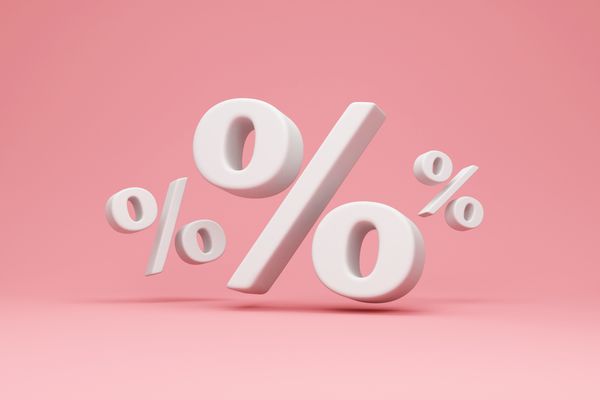Credit Card Interest Rates: What is It and How It Works?

What is Credit Card Interest Rate?
A credit card interest rate is the percentage of the amount you spend using a credit card that you have to pay back in addition to the original amount, over a certain period of time. Since a credit card is a revolving credit facility, the amount spent by the user through the card is considered a short-term loan which attracts interest in certain scenarios.
When is the Interest Charged on Credit Card?
As mentioned earlier, credit card interest rates are charged in certain scenarios. Let’s dig deep:
1. When you Pay Only the Minimum Amount Due
Your credit card company will charge interest if you pay only the minimum amount due, which is typically just 5% of the total outstanding due. The interest will be charged on the remaining amount (i.e. total outstanding – minimum amount due), plus any new spending, unless the dues are cleared in full.
2. When you Withdraw Cash Using your Credit Card
When you withdraw cash at an ATM using your credit card, it’s called a cash advance. Credit card companies will charge interest on the full cash advance amount from the first day, along with a cash advance fee, until the amount is paid back in full.
3. When you Pay Less than the Total Outstanding Due
If you carry forward any outstanding amount, your credit card company will charge interest on it until the entire balance is paid back in full.
4. When you Make No Payment at All
If you don’t even pay the minimum amount due, you’ll be charged interest on the entire outstanding amount along with other penalties. This is also likely to lead to a credit score drop for the user.
High Interest Rate Credit Cards in India in 2023
Here is a list of some of the credit cards in India that have a high-interest rate. Do note, this data is for illustrative purposes only and the credit card issuers can change interest rates at their discretion. Also, the rates could vary from customer to customer :
| Credit Card | Monthly Percentage Rate | Annual Percentage Rate |
| Amazon Pay ICICI Credit Card | Up to 3.8% | Up to 45.6% |
| Standard Chartered Digismart | 3.75% | 45% |
| Axis Bank ACE Credit Card | 3.6% | 52.86% |
| HDFC Regalia Credit Card | 3.6% | 43.2% |
| HDFC Bank Diners Club Privilege | 3.6% | 43.2% |
| SBI Elite | 3.5% | 42% |
| American Express Platinum Reserve | 3.5% | 42% |
| HSBC Cashback Credit Card | 3.49% | 41.88% |
| Flipkart Axis Bank Credit Card | 3.4% | 49.36% |
| ICICI Bank Platinum Chip Credit Card | 3.4% | 40.8% |
Low Interest Rate Credit Cards in India in 2023
Here are some of the low interest-charging credit cards in India. The data is for illustrative purposes only and the credit card issuers can change interest rates at their discretion. Also, the rates could vary from customer to customer :
| Credit Card | Monthly Percentage Rate |
| Kotak Mahindra Best Price Premium | 1.5% |
| HDFC Diners Club Black | 1.99% |
| HDFC Infinia Metal | 1.99% |
| SBI Advantage Platinum | 1.99% |
| SBI Advantage Gold | 1.99% |
| ICICI Bank Instant Platinum | 2.49% |
| ICICI Bank Instant Gold | 2.49% |
| Bank of Baroda Signature VISA | 2.6% |
Also Read
Formula to Calculate Credit Card Interest
The formula to calculate credit card interest is as follows:
- Credit card interest = (Number of days counted from the date of transaction x outstanding amount x Interest rate per month x 12 months) / 365
So, if the number of days from date of transaction is 5 days, Outstanding amount is ₹1,000 and Interest rate per month is 3%
Credit card interest would be: (5×1,000x3x12)/365 = ₹493
And total outstanding would be: 1000+493 = ₹1,493
How to Calculate Credit Card Interest?
To calculate credit card interest, the first thing you need to know is the APR decided by your credit card company. You can check the card terms and conditions or get in touch with a customer service representative to get the details.
Here are three simple steps you can follow to calculate your monthly credit card interest.
Step 1: Calculate the DPR
As noted above, you can calculate the daily periodic rate of your credit card by dividing the APR by 365. You can find the APR in the agreement detail that is issued by the credit card company. Don’t forget to convert the APR into a decimal number so that it can be divided by 365.
DPR = (APR/100)/365
Example:
For example, if your card has an 18% APR, your DPR will be 0.00049%.
Note: Most credit card companies or banks also offer cards that follow a monthly percentage rate (MPR).
Step 2: Calculate the average of your Daily Credit Card Balance
To calculate the average of your daily credit card balance during the billing cycle, you need to add the balance values of each day and divide the summation by the total number of days in the billing cycle.
Example:
Let’s understand this with the help of an example. Let’s say your billing cycle is 4 days and the following balances on your credit card for each day of the billing cycle.
| Days | Transactions | Balance |
| Day 1 | ₹5000 purchase | ₹5000 |
| Day 2 | None | ₹5000 |
| Day 3 | None | ₹5000 |
| Day 4 | ₹1000 purchase | ₹6000 |
So, the average of your daily credit card balance is (5000+5000+5000+6000)/4 = Rs 5250.
This way, you can calculate the average daily credit card balance. Please note that if you have any outstanding amount from last month, it should be added to the summation as well.
Step 3: Calculate how much interest you have to pay
Here is the formula to calculate your credit card interest.
Credit Card Interest = (Average Daily Balance x DPR) / Number of Days in Your Billing Cycle
If you go by the information in the examples, the interest would be
(5250 x 0.00049) / 4 = Rs 0.64.
What is a Credit Card Interest-free Period?
Most credit card companies offer an interest-free period to their users for regular card spends. The grace period varies on a company-to-company basis. It starts from the day the monthly statement is generated to the day the payment is due.
If you pay your credit card bill during the interest-free period, there will be no outstanding amount on your card that you will be charged interest for. Always plan your credit card spends to ensure you clear the dues in full during the interest-free period of up to 50 days so that you are charged with no interest.
Also, you will get no interest free period for any cash advance as interest would be charged from the day of advance itself. Also, if you miss a credit card payment, you might not get any interest free period until you clear all the outstanding dues in full.
Final Word
Credit cards can be of immense help if you plan your expenses accordingly and never overspend. It also might be a good idea to be aware of your credit card interest rates so that you can plan your repayments accordingly. However, you might want to go for a credit card with a low interest rate that allows you to incentivise your frequent card spends.
And if you’re looking for urgent cash to fund an immediate requirement, you can also consider an instant Navi Cash Loan. Get a loan up to ₹20 lakh starting at just 9.9% p.a. with 0 foreclosure charges. Just download the Navi app, enter basic details, check your loan offer and get funds transferred to your account in a few minutes!
FAQs
You do not have to pay any interest if you pay the bill in full between the monthly statement date and the due date of the bill. Avoid keeping any outstanding amount on your card for each billing cycle.
The typical monthly interest rate on credit cards can vary between 2% to 4%. It depends on the credit card issuing company. It is advisable to select companies that offer low credit card interest rates.
Interest will be charged on your card’s outstanding balance even if you pay the minimum amount due. The remaining amount will get carried forward to the next bill.
The grace period depends on the sole discretion of the card-issuing company or bank. If it is offered by the issuer, the interest-free period can be anywhere from 18-48 days to 25-55 days.
The interest rates on credit cards may change at the will of the card-issuing company or bank. However, the issuer will provide a notice to the users before implementing any changes.
This article has been prepared on the basis of internal data, publicly available information and other sources believed to be reliable. The information contained in this article is for general purposes only and not a complete disclosure of every material fact. It should not be construed as investment advice to any party. The article does not warrant the completeness or accuracy of the information, and disclaims all liabilities, losses and damages arising out of the use of this information. Readers shall be fully liable/responsible for any decision taken on the basis of this article.

Customer’s Feedback
No comments found.10 Best Bank for Savings Account in India [Highest Interest Rate 2023]
Savings account is a type of financial instrument offered by several banks. It lets you safely depo... Read More »What is Issuer Identification Number (IIN)- Working and Importance
What is an Issuer Identification Number (IIN)? Banks and financial institutions assign a distinc... Read More »What is a Vostro Account – Meaning, Working and Difference
What is a Vostro Account? A Vostro account is a bank account held by a domestic bank on behalf o... Read More »What is a Solvency Certificate? – Format, Documents Required & How to Apply Online?
What is a Solvency Certificate? A solvency certificate is a legal document furnishing the detail... Read More »What is Merchant Banking – Services, Features, Functions and Example
What is Merchant Banking? Merchant banking is a set of select banking and financial services off... Read More »Automated Clearing House: Objectives, Types and Process
Automated Clearing House is an electronic fund transfer network that manages automatic and direct... Read More »How to Redeem Credit Card Reward Points ?
Credit Card Reward points are types of incentives that customers receive when they use a credit car... Read More »What is Electronic Clearing Service (ECS) in Banking and How does it Work?
What is Electronic Clearing Service (ECS)? Electronic Clearing Service (ECS) is a method of elec... Read More »What are Credit Card Validators and How to Use them?
What is a Credit Card Validator? A credit card validator is a tool that checks the validity of a... Read More »What is Cash Management and How Does it Work?
Managing available capital can make sure that a small business stays afloat. Cash management is an ... Read More »What are Prepaid Expenses? – Definition, Examples, and Journal Entry
Prepaid expenses represent payments made in advance for products or services expected to be incurre... Read More »Increase Credit Card Limit – Important Tips and How to Do It?
The credit card limit is the maximum amount of money you can spend using your credit card. Your cre... Read More »Top 10 Chit Fund Schemes in India in 2023
Chit funds are one of the most popular return-generating saving schemes in India. It is a financial... Read More »10 Best Gold ETFs in India to Invest in April 2023
Gold ETFs or Gold Exchange Traded Funds are passively managed funds that track the price of physica... Read More »10 Best Demat Accounts in India for Beginners in 2023
Creation of Demat accounts revolutionised the way trades were conducted at the stock exchanges. It... Read More »20 Best Index Funds to Invest in India in April 2023
What is an Index Fund? An index fund is a type of mutual fund or exchange-traded fund (ETF) that... Read More »Best Arbitrage Mutual Funds to Invest in India in April 2023
Arbitrage funds are hybrid mutual fund schemes that aim to make low-risk profits by buying and sell... Read More »10 Best SIP Plans in India to Invest in April 2023
What is SIP? SIP or Systematic Investment Plan is a method of investing a fixed amount in ... Read More »10 Best Corporate Bond Funds in India to Invest in April 2023
Corporate bond funds are debt funds that invest at least 80% of the investment corpus in companies ... Read More »10 Best Bank for Savings Account in India [Highest Interest Rate 2023]
Savings account is a type of financial instrument offered by several banks. It lets you safely depo... Read More »





















